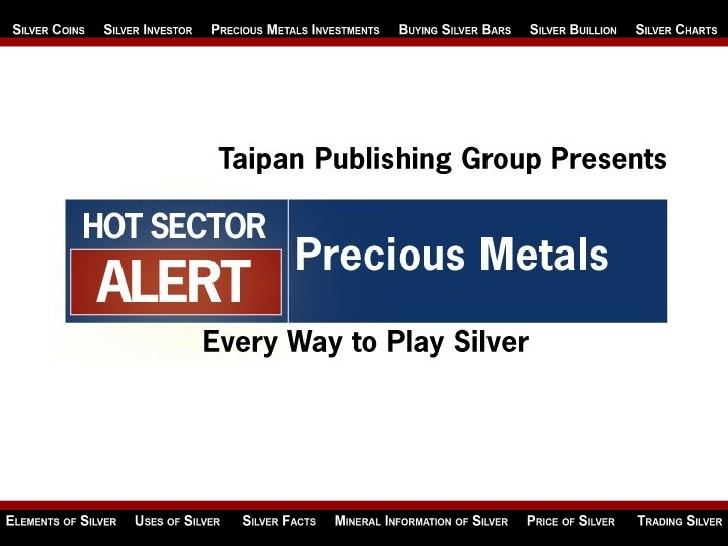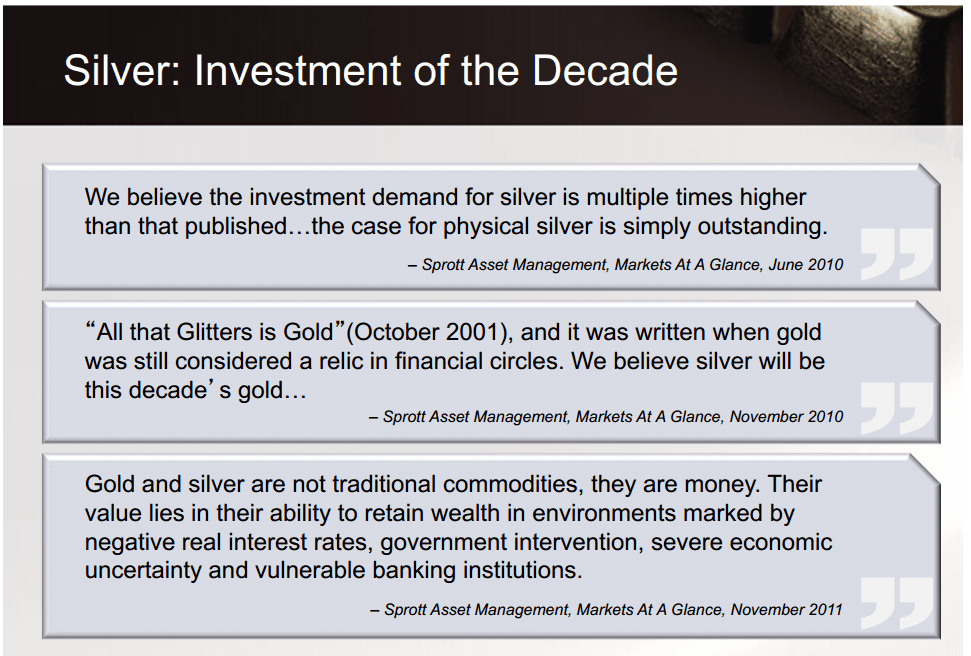Why Silver ETF is hot investment
Post on: 31 Март, 2015 No Comment

FOLLOW US
SLV was born in late April 2006, so it is relatively young as far as exchange-traded funds go. Though its birth was shrouded in controversy, SLV has rapidly grown into a smashing success. Now holding $10.2b worth of phys..
17 Jan 2011
By Adam Hamilton
Silvers massive autumn rally has utterly captivated speculators and investors, their appetite for all things silver is insatiable. Interestingly a major driver of this metals recent surge was stock-market buying of the flagship silver ETF, SLV. The larger and more popular this fund grows, the greater its ongoing impact on silver prices.
SLV was born in late April 2006, so it is relatively young as far as exchange-traded funds go. Though its birth was shrouded in controversy, SLV has rapidly grown into a smashing success. Now holding $10.2b worth of physical silver bullion in trust for its shareholders, it is already one of the worlds largest ETFs. And as more stock investors get interested in silver exposure, SLV will only continue to grow.
Prior to its launch, the industrial silver consumers lobbied hard to try and convince the SEC to deny approval for this new physical-silver ETF. The Silver Users Association, whose members process 80% of all the silver used in the US, wrote a letter to the SEC in February 2006. It warned the SUA opposes the creation of a silver ETF because of the concerns that doing so will require the holding of physical silver in allocated accounts, thus removing large amounts of silver from the market.
And indeed the industrial silver consumers fears have come to pass. In mid-December 2010, SLVs holdings hit an all-time high of 352.5m ounces of silver bullion! To put this into perspective, global silver production in 2009 ran about 700m ounces. American stock investors, by buying shares in SLV, have already absorbed the equivalent of half a years worth of all the silver mined in the world.
Provocatively about 1/6th of SLVs total silver hoard was acquired in less than 5 months between late-July and mid-December 2010. SLVs holdings shot up 18.9% during silvers massive 76.0% autumn rally we saw last year. This is no mean feat! The 55.8m ounces of silver this ETF had to buy over this short span is staggering.
One of the largest primary silver miners in the world, Pan American Silver, expected to produce around 24m ounces in 2010. US stock investors, through the mechanism of SLV, snatched up 2.3x PAASs entire 2010 production in less than 5 months! This young ETF has already grown into a silver juggernaut, an irresistible force that every silver speculator and investor must keep a close eye on.
Though physical ETFs have been around since the enormous GLD gold ETFs debut in November 2004, unfortunately many investors still dont understand how they work. The mission of an ETF is to track the price of its underlying asset, to mirror the underlyings performance. Since real-time supply and demand determines all prices, this tracking mission can only be accomplished in one way. A physical ETF has to act as a direct conduit to move capital between investors and the underlying asset.
In SLVs case, this silver ETF and silver itself have their own independent supply-and-demand profiles. If you decide to buy 100 ounces of physical silver coins today, it doesnt affect SLV. And if an SLV shareholder sells 100 shares, it doesnt directly affect physical silver. So if capital wasnt flowing back and forth between this ETF and the physical world, SLV would quickly decouple from silver prices and fail its tracking mission.
Physical ETFs like SLV succeed because they equalize their own supply and demand into their underlying assets on a daily basis. SLV actually has to buy and sell physical silver, otherwise it could not track silver prices. And since its launch, SLV has tracked silver prices perfectly less its 0.5% annual expense ratio. For providing this valuable service, every year SLVs custodians take a half percent of the funds assets to pay their expenses (including storing the silver bullion) and earn a reasonable profit.

SLV has to buy silver bullion when stock investors are buying its shares at a faster rate than silver itself is being bought. This differential buying pressure on SLV, if not shunted directly into silver itself, would quickly lead to SLV decoupling to the upside (rising faster than silver) and failing its mission. So in these situations, SLV issues new shares (in huge 50k baskets). This mechanism is critical for tracking.
Issuing new shares first adds SLV supply to the market to absorb the excess demand, which keeps SLV shares from rising faster than silver. SLVs custodians then take the proceeds, the cash earned from selling these new shares, and plow it directly into silver bullion. This equalizes the excess stock-market demand for SLV shares into underlying silver itself. This silver buying drives up silver prices to keep them in line with SLV demand. Thus SLV shunts stock-market capital directly into physical silver.
But opening a large conduit between the vast pools of stock-market capital and the relatively-tiny silver market is a double-edged sword. When stock investors sell SLV shares at a faster rate than silver is being sold, this differential selling pressure will force SLV to decouple to the downside. In order to prevent this ETF from falling faster than silver and failing its tracking mission, SLVs custodians have to buy back shares to absorb this excess supply.
Where do they get the cash? From selling some of their silver bullion. Again in huge blocks of 50k shares (each share represents one ounce of silver), SLVs custodians sell however much silver is necessary to fund the buying back of enough shares to absorb the excess SLV share supply. This equalizes excess stock-market supply of SLV shares into silver. This ETFs silver selling also drives down silver prices to keep them in line with SLV supply. So SLV can also shunt stock-market capital directly out of silver.
Without this conduit, a link for capital to flow back and forth from stock investors and the underlying asset, a tracking ETF cant work. So watching the flowing and ebbing of SLVs holdings offers fantastic insights into how stock investors view silver. When they put differential buying pressure on SLV forcing it to buy silver, more capital is flowing into the global silver markets. When they sell SLV fast forcing it to liquidate silver, capital is flowing out. Thankfully SLV is super-transparent, publishing its holdings data daily.
Dont underestimate how radical so much disclosure is in the precious-metals markets! One of the main reasons conspiracy theories thrive in the PM world is because actual data is so hard to come by. In the case of gold and silver, fundamental data like supply and demand is heavily fragmented and often only available quarterly (and even then it is only estimates). So SLVs daily holdings offer an unprecedented high-resolution read on a critical aspect of global silver supply and demand, how American stock investors feel about it.
And as this chart shows, since SLVs humble beginnings stock investors have grown increasingly fond of the white metal. As of its recent record high in mid-December, SLVs holdings had multiplied by 16.8x over the short life of this ETF! With such a mammoth footprint today, no silver speculator or investor can afford to ignore this behemoths activities. SLVs silver-price impact is already large and still growing.














